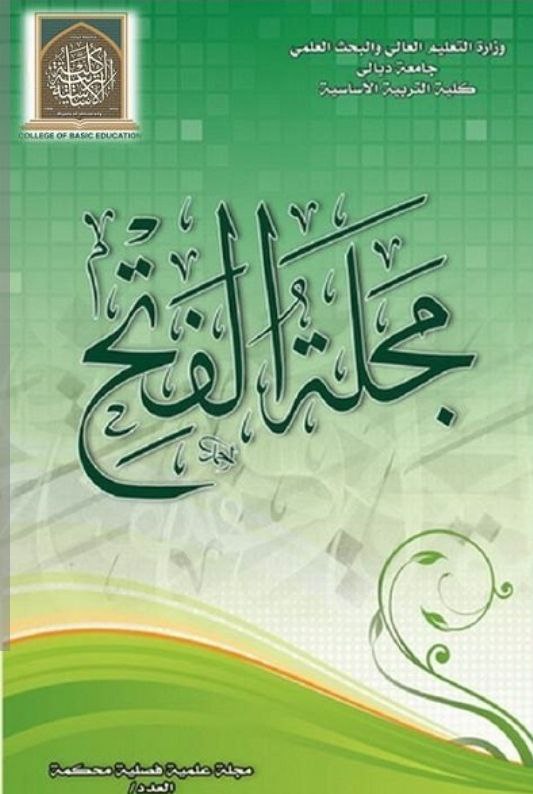Excessive self-confidence among students who excelled academically in the preparatory stage
Abstract
The outstanding students in preparatory schools for girls encounter
new experiences, as they have to deal and collaborate with such
experience according to their capacities and abilities, although they
may have certain level of conceitedness and self overconfidence
because of sentiments of difference from others and individuation,
and having extraordinary, unlimited and pivotal capabilities, along
with an abundant level of activeness as well as having strong
motives for learning and working, in addition to an enthusiastic
motivation for exploration, investigation and experimentation. This
causes some problems and difficulties for such outstanding students,
since the self overconfidence is considered a negative trait, which
may obstruct the self overconfident student and deprives her from
success, in which her talents and excellence can qualify her to
achieve it. This negative feature may perhaps disrupt the
relationship between such students and their teachers, the
outstanding students curiousness, their persistent movements and
contiguous enquiries often cause state of confusion and discomfort
to teachers, and leading ultimately to more troubles. Teachers may
look to those excellent students as being chaotic, undisciplined
persons, abusers and troublemakers. Therefore, those students
should be assisted to resisted these pressures and comprehend, their
intellectual, social and emotional need at very phase of their
evolution for the effective and significant role played by this
category in building the society and its development.
This paper aims at discovering the level of over-self confidence in
outstanding girl students of preparatory schools. In order to achieve
References
-اثٞ أٍؼل، أؽٔل ػجلاُِط٤ق، )2011 :)اهشبك أُزلٞه٤ ،ٖؽ1 ، كاه أَُ٤وح ُِطجبػخ
ٝاُ٘شو، ػٔبٕ، األهكٕ.
-اثٞ أٍؼل، أؽٔل ػجلاُِط٤ق-ػو٣جبد، اؽٔل ػجلاُؾِ٤( ،ْ2012ٗ :)ظو٣بد االهشبك
اُ٘لَ٢ اُزوثٞ١ ،ؽ2 ، كاه أَُ٤وح ُِطجبػخ ٝاُ٘شو، ػٔبٕ، األهكٕ.
ثؼجؾ اُناد ُلٟ االؽجبء، هٍبُخ ٓبعَز٤و، ًِ٤خ ا٥كاة، عبٓؼخ ثـلاك0اُغ٘بث٢ٍ ،الّ اؽٔل ؿغو،)2006 :)اُضوخ أُلوؽخ ك٢ االؽٌبّ االؽزٔبُ٤خ ٝػالهزٜب
ٝاُزٞى٣غ، اٌُٞ٣ذ0اُلؽبكؽخ، ثبٍْ ٓؾٔل ػِ٢( ،2010:) االهشبك ٝاُؼالط اُ٘لَ٢ ،ؽ1ٌٓ،زجخ اُلالػ ُِ٘شو
،ػٔبٕ ، االهكٕ0كهٙ، ػجلاُجبه١ اثواٛ٤( ،ْ2013 :)أُٜبهاد اُؼشو ُِضوخ ثبُ٘لٌ، ؽ2،كاه ٝائَ ُِ٘شو
أُٞٛٞث٤ ،ٖاؽوٝؽخ كًزٞهاٙ، ًِ٤خ اُزوث٤خ، عبٓؼخ ثـلاك0اُلٛٞ١ ،ؽ٤له ؽٔ٤ل عؼلو)2006 :)أٌُبٍ اُوَو١ٝ اُزقو٣ت ػِ٠ اُناد ُلٟ اُطِجخ
-هث٤غ ،ٓؾٔل شؾبرٚ، )2013:)ه٤بً اُشقظ٤خ،ؽ4 ،كاه أَُ٤وح ُِطجبػخ ٝاُ٘شو،
ػٔبٕ، األهكٕ.
اُلالػ ُِ٘شو ٝاُزٞى٣غ، اٌُٞ٣ذ0اُوش٤ل١ ،ثش٤و طبُؼ-اََُٜ، هاشل ػِ٢(، 2000ٓ:)ولٓخ ك٢ االهشبك اُ٘لَ٢ٌٓ ،زجخ
-ٍِلوٓبٕ، ُ٤٘لا ًو٣وو،)2014:)اهشبك أُزلٞه٤ٝ ٖأُٞٛٞث٤ ،ٖؽ4،روعٔخ ٍؼ٤ل ؽَ٘٢
اُؼيح، كاه اُضوبكخ ُِطجبػخ ٝاُ٘شو، ػٔبٕ، األهكٕ.
أُو٣ـ ، اُو٣بع ، اَُؼٞك٣خ0اُوبػ٢ ،٣ٍٞق ٓظطل٠ٝ افوٕٝ، )2002 :)االهشبك اُ٘لَ٢ٝ اُزٞع٤ ٚاُزوثٞ١ ،كاه
-اُ٘ؼ٤ٔ٢ٜ٘ٓ ،ل ٓؾٔل ػجلاَُزبه، )2014 : )اُو٤بً اُ٘لَ٢ ك٢ اُزوث٤خ ٝ ػِْ اُ٘لٌ،
أُطجؼخ أُوًي٣خ، عبٓؼخ ك٣بُ٠، اُؼوام.
ٝاهشبكْٛ ٗلَ٤ب ٝكهاٍ٤ب، ht.newpag/com.childguidanceclinice.wwwاُلبػٞه ،ا٣ٓ ْٜؾٔل-ٝاُقِق،ؽَبّ اؽٔل،)2013 :)أُشٌالد اُ٘لَ٤خ ُِٔزلٞه٤ ٖ
-Anastasi, M. & Urbina, A. (1997). Education measurementmegrim, Hill-Book, New York.
Downloads
Published
How to Cite
Issue
Section
License
Copyright (c) 2023 مجلة الفتح للبحوث النفسية والتربوية

This work is licensed under a Creative Commons Attribution 4.0 International License.



